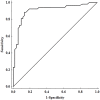Increased plasma clot permeability and susceptibility to lysis are associated with heavy menstrual bleeding of unknown cause: a case-control study
- PMID: 25909989
- PMCID: PMC4409067
- DOI: 10.1371/journal.pone.0125069
Increased plasma clot permeability and susceptibility to lysis are associated with heavy menstrual bleeding of unknown cause: a case-control study
Abstract
Background: Formation of compact and poorly lysable clots has been reported in thromboembolic disorders. Little is known about clot properties in bleeding disorders.
Objectives: We hypothesized that more permeable and lysis-sensitive fibrin clots can be detected in women with heavy menstrual bleeding (HMB).
Methods: We studied 52 women with HMB of unknown cause and 52 age-matched control women. Plasma clot permeability (Ks), turbidity and efficiency of fibrinolysis, together with coagulation factors, fibrinolysis proteins, and platelet aggregation were measured.
Results: Women with HMB formed looser plasma fibrin clots (+16% [95%CI 7-18%] Ks) that displayed lower maximum absorbancy (-7% [95%CI -9 - -1%] ΔAbsmax), and shorter clot lysis time (-17% [95%CI -23 - -11%] CLT). The HMB patients and controls did not differ with regard to coagulation factors, fibrinogen, von Willebrand antigen, thrombin generation markers and the proportion of subjects with defective platelet aggregation. The patients had lower platelet count (-12% [95%CI -19 - -2%]), tissue plasminogen activator antigen (-39% [95%CI -41 - -29%] tPA:Ag), and plasminogen activator inhibitor-1 antigen (-28% [95%CI -38 - -18%] PAI-1:Ag) compared with the controls. Multiple regression analysis upon adjustment for age, body mass index, glucose, and fibrinogen showed that decreased tPA:Ag and shortened CLT were the independent predictors of HMB.
Conclusions: Increased clot permeability and susceptibility to fibrinolysis are associated with HMB, suggesting that altered plasma fibrin clot properties might contribute to bleeding disorders of unknown origin.
Conflict of interest statement
Figures



Similar articles
-
Denser plasma clot formation and impaired fibrinolysis in paroxysmal and persistent atrial fibrillation while on sinus rhythm: association with thrombin generation, endothelial injury and platelet activation.Thromb Res. 2015 Aug;136(2):408-14. doi: 10.1016/j.thromres.2015.05.028. Epub 2015 May 29. Thromb Res. 2015. PMID: 26048399
-
Altered plasma fibrin clot properties in essential thrombocythemia.Platelets. 2016;27(2):110-6. doi: 10.3109/09537104.2015.1042967. Epub 2015 May 19. Platelets. 2016. PMID: 25989112
-
Prolonged duration of type 2 diabetes is associated with increased thrombin generation, prothrombotic fibrin clot phenotype and impaired fibrinolysis.Thromb Haemost. 2014 Apr 1;111(4):685-93. doi: 10.1160/TH13-07-0566. Epub 2013 Dec 5. Thromb Haemost. 2014. PMID: 24306139
-
Anabolic-Androgenic Steroid Abuse Impairs Fibrin Clot Lysis.Semin Thromb Hemost. 2021 Feb;47(1):11-17. doi: 10.1055/s-0040-1714398. Epub 2020 Oct 5. Semin Thromb Hemost. 2021. PMID: 33017849 Review.
-
Thrombin activatable fibrinolysis inhibitor (TAFI) at the interface between coagulation and fibrinolysis.Pathophysiol Haemost Thromb. 2003 Sep-2004 Dec;33(5-6):375-81. doi: 10.1159/000083832. Pathophysiol Haemost Thromb. 2003. PMID: 15692247 Review.
Cited by
-
Fibrinolysis and bleeding of unknown cause.Res Pract Thromb Haemost. 2021 Apr 7;5(4):e12511. doi: 10.1002/rth2.12511. eCollection 2021 May. Res Pract Thromb Haemost. 2021. PMID: 34027290 Free PMC article.
-
Plasmin generation analysis in patients with bleeding disorder of unknown cause.Blood Adv. 2024 Nov 12;8(21):5663-5673. doi: 10.1182/bloodadvances.2024012855. Blood Adv. 2024. PMID: 39231312 Free PMC article.
-
Plasma Fibrin Clot Properties as Determinants of Bleeding Time in Human Subjects: Association with Histidine-Rich Glycoprotein.Dis Markers. 2020 Jan 25;2020:7190828. doi: 10.1155/2020/7190828. eCollection 2020. Dis Markers. 2020. PMID: 32076463 Free PMC article.
-
Fibrinolytic assays in bleeding of unknown cause: Improvement in diagnostic yield.Res Pract Thromb Haemost. 2022 Mar 15;6(2):e12681. doi: 10.1002/rth2.12681. eCollection 2022 Feb. Res Pract Thromb Haemost. 2022. PMID: 35316940 Free PMC article.
-
Clotting Factor Concentration During Menstrual Phases in Women With and Without Heavy Menstrual Bleeding: A Systematic Review and Meta-Analysis.Haemophilia. 2025 Jul;31(4):780-786. doi: 10.1111/hae.70076. Epub 2025 Jun 19. Haemophilia. 2025. PMID: 40534379 Free PMC article.
References
-
- Vessey MP, Villard-Mackintosh L, McPherson K, Coulter A, Yeates D. (1992) The epidemiology of hysterectomy: findings in a large cohort study. Br J Obstet Gynaecol 99: 402–407. - PubMed
-
- Cote I, Jacobs P, Cumming D. (2002) Work loss associated with increased menstrual loss in the United States. Obstet Gynecol 100: 683–687. - PubMed
-
- Kujovich JL. (2005) von Willebrand’s disease and menorrhagia: prevalence, diagnosis, and management. Am J Hematol 79: 220–228. - PubMed
-
- Philipp CS, Dilley A, Miller CH, Evatt B, Baranwal A, Schwartz R, et al. (2003) Platelet functional defects in women with unexplained menorrhagia. J Thromb Haemost 1: 477–484. - PubMed
Publication types
MeSH terms
Substances
LinkOut - more resources
Full Text Sources
Other Literature Sources
Miscellaneous

